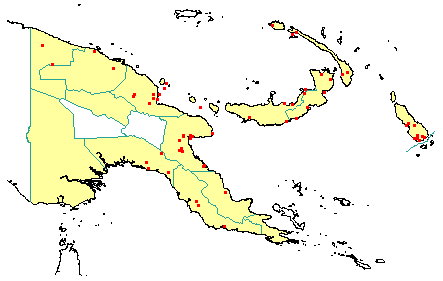
in PNGplants database
PNGTreesKey – Vitex cofassus Reinw. ex Blume |
Barry Conn (NSW) & Kipiro Damas (LAE).
Guide to trees of Papua New Guinea
Copyright held by the authors, National Herbarium of New South Wales, and Papua New Guinea National Herbarium
Flora van Nederlandsch Indië 813
Other Literature: D.B. Foreman, Checklist of the Vascular Plants of Bougainville 178 (1971) Fig. 178.
Family: Lamiaceae
Dicotyledon
Timber Group: Major exportable hardwood Tradename: New Guinea Teak
Field Characters: Large canopy tree (up to 33 m high); Bole cylindrical (sometimes 30-170 cm diam.) or markedly fluted; crooked or straight (bole up to 18 m long); buttresses buttresses present (buttresses up to 6 m high); spines spines absent; aerial roots aerial roots absent; stilt roots stilt roots absent; Bark pale grey or pale brown, slightly rough or mostly smooth, slightly pustular, rarely scaly or flaky, rarely fissured, or peeling, lenticels rounded/swelling; Subrhytidome (under-bark) brown; less than 25 mm thick, 6.0-10.0; bark blaze consisting of one layer; faintly to non-aromatic; pleasant; outer blaze white, yellow, orange (Check with photo!), or mixed colours, with stripes, rarely smooth or fibrous; inner blaze white, yellow, or mixed colours, with stripes, rarely smooth or fibrous (with splinters); bark exudate (sap) present, colourless, not readily flowing (spotty), colour changing on exposure to air, to black, not sticky; terminal buds not enclosed by leaves.
Indumentum: Complex hairs absent; stinging hairs absent; mature twig indumentum (hairs) present (hairs short, inconspicuous) or absent, hairs sparse (mostly at nodes).
Leaves: Leaves spaced along branches, opposite (in pairs, opposite one another on the branchlet), compound (a leaf made up from two or more leaflets) (often misinterpretated as simple because leaves are unifoliate compound); petiole present, not winged, attached to base of leaf blade, swollen (slightly (at base and tip); leaves with one leaflet; petiolule not swollen; rachis absent; leaves with a terminal leaflet (the number of leaflets odd - imparipinnate), broadest at or near middle or broadest below middle, (10.0-) 12.0-22.0 cm, 5.0-10.0 cm, leaflets arranged from one point (only one leaflet), symmetric, terminal developing leaflet buds straight; venation pinnate, secondary veins open, not prominent, but visible, intramarginal veins absent; leaves lower surface green, upper surface green (sub-glossy), indumentum (hairs) absent; absent; domatia absent; stipules absent.
Flowers: Inflorescence terminal or leaf-opposed, flowers on a branched axis, cones absent; flowers bisexual, stalked, flowers with one plane of symmetry, 4.0-10.0 mm long, diameter small (up to10 mm diam.); perianth present, with distinct sepals and petals whorls, inner perianth pale purple or pale mauve; 5, some or partly joined; stamens 4, present, free of each other, joined to the perianth; ovary superior, carpels joined (when more than one), locules 5; styles solitary, 1.
Fruits: Infrutescence arranged on branched axis, fruit 10.0-12.0 mm long, 10.0 (c.) mm diam., green, grey, or black, not spiny, non-fleshy, simple, indehiscent, drupe; seeds usually 1-4, to about 5 mm long, not winged, narrow (longer than wide), seed 1-10 mm diam. (c. 4 mm diam.).
Distribution: West Sepik, East Sepik, Madang, Morobe, Western Highlands, Western, Gulf, Central, Northern, Milne Bay, New Britain, New Ireland & Bougainville.
 | Botanical records in PNGplants database |
Notes: Notes Formerly included in the family Verbenaceae. Now regarded as part of the Lamiaceae subfamily Viticoideae.